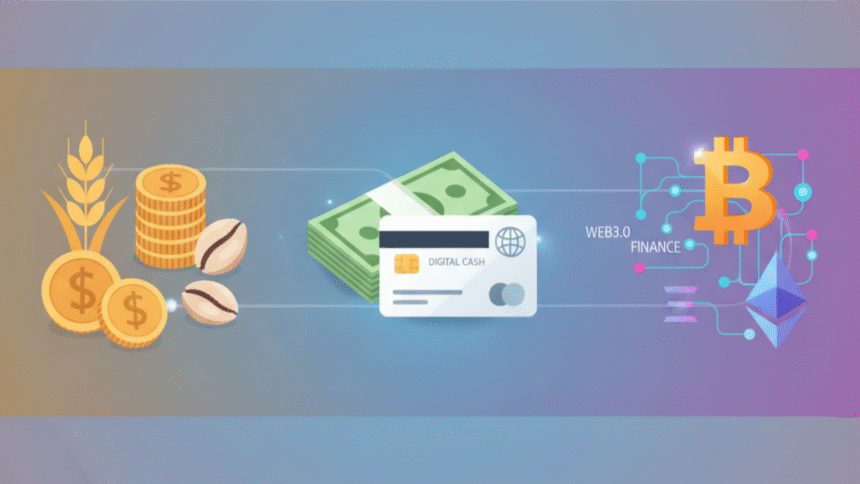The history of money is a continuous narrative of human innovation, driven by the need for more efficient and trustworthy systems of exchange. The evolution has progressed through three distinct eras, each defined by a fundamental shift in the locus of trust. The first, the Era of Intrinsic Trust, was characterized by the physical exchange of goods with inherent value, such as in the barter system or through commodity money. Trust in this period was localized and tangible, based on the physical worth of the item being exchanged.
This was followed by the Era of Centralized Trust, which began with the introduction of fiat currencies and solidified with the rise of modern digital banking. In this era, the value of money is no longer tied to a physical commodity but is derived from government decree and public confidence. This system, while offering immense flexibility and scale, places trust in a handful of central, regulated intermediaries, such as banks and governments.
The latest chapter, the Era of Decentralized Trust, is a direct response to the perceived vulnerabilities of the centralized model. Fuelled by a crisis of confidence in the traditional financial system, the Web3 movement seeks to replace trust in institutions with trust in immutable code and cryptographic protocols. This report will explore the defining characteristics of each era, arguing that while Web3 presents a compelling vision of decentralization, its current manifestations face significant challenges, including a “decentralization illusion” and a new class of systemic risks. The ultimate future of money may not be a simple replacement of one system with another but a complex, integrated ecosystem that selectively adopts the innovations of Web3 while retaining the stability of traditional finance.
1. The Age of Trust: From Tangible Value to Centralized Fiat
To overcome the inherent limitations of barter, societies gradually adopted commodity money. These were items with intrinsic value, such as salt, grain, or cattle, that served as a standard medium of exchange. While an improvement, they were still limited by their bulk and perishable nature. This led to the widespread adoption of precious metals like gold and silver, which were durable and easily divisible, making them far superior for trade. The first known coins, stamped with images to certify their authenticity and weight, appeared in ancient Lydia (modern-day Turkey), paving the way for standardized currency that could facilitate trade across vast empires.
This marked a crucial transition from relying on the physical commodity’s value to trusting a centralized authority to certify its worth. The evolution continued with the introduction of paper money in China, a revolutionary concept that provided a lightweight and portable form of currency. As economies expanded, banking institutions emerged in Europe to handle these notes, which were initially issued as promissory notes. This created a system where trust was no longer placed in the physical coin but in the financial institution promising to redeem it.
The final and most significant transformation in this era was the abandonment of the gold standard in the 20th century, which gave rise to fiat money. Unlike commodity-backed currency, fiat money has no intrinsic value but derives its worth from government decree and public trust. The decision to transition to this system was born from a paradox. While the gold standard provided a measure of monetary stability, it also restricted governments’ ability to respond to economic crises by controlling the money supply. The shift to fiat currency offered greater flexibility in economic policy, but it also introduced new, systemic risks: a currency’s value is now susceptible to political manipulation and devaluation from inflation. This fundamental vulnerability of centralized trust, which places faith in human-governed institutions, would become the primary motivation for the next great evolution in money.
2. The Digital Leap: Centralized Banking in the Information Age
The mid-20th century witnessed the next major leap in money’s evolution, as traditional financial services began their migration to the digital realm. This era began with simple automation tools like ATMs and credit cards in the 1960s, which provided remote access to cash and credit. The advent of the internet in the 1990s brought internet banking, allowing customers to check balances, transfer funds, and pay bills from their homes. The true revolution, however, was spurred by the widespread adoption of smartphones and mobile applications in the 2000s, which made banking services accessible to millions at their fingertips.
Despite this user-facing revolution, the underlying architecture of digital banking remains a deeply centralized system. A typical electronic payment involves a complex, multi-party network. A consumer initiates a payment, which is then processed by their bank (the issuer bank) and the merchant’s bank (the acquirer bank) through secure, regulated payment networks. This intricate, behind-the-scenes system ensures that every transaction is verified, funds are available, and the payment is processed securely and efficiently.
The appearance of decentralized access via a mobile app conceals the centralized nature of the control and trust mechanisms. The entire system operates under the strict oversight of a vast regulatory framework and requires financial institutions to implement rigorous financial controls. Regulators, such as the Federal Deposit Insurance Corporation (FDIC), mandate that banks maintain detailed records, ensure compliance with laws like the Sarbanes-Oxley Act, and have policies in place to prevent fraud and financial abuse. This structure, while providing security and reliability, creates a state of “centralized decentralization”—where the interface is user-friendly and accessible from anywhere, but the core infrastructure and the final authority over all transactions remain in the hands of a few trusted, regulated intermediaries. This leaves the system vulnerable to the same institutional failings that would eventually give rise to the Web3 movement.
3. The Genesis of a New Paradigm: The Vision of Web3
The genesis of the Web3 movement, and specifically the birth of Bitcoin, can be directly traced to the 2008 global financial crisis. The collapse of major financial institutions and the subsequent economic turmoil created a profound crisis of confidence in the conventional financial system and its overleveraged intermediaries. Amid this distrust, the original Bitcoin white paper was released, proposing a radical new vision: a self-sustaining, peer-to-peer system of electronic cash that would allow for direct transfers without the need for a central, trusted third party, such as a bank.
The philosophical underpinnings of this movement represented a dramatic departure from the historical drivers of money’s evolution. While the progression from barter to fiat was primarily motivated by the pursuit of greater economic efficiency and convenience, the Web3 paradigm was born from an ideological imperative: a demand for personal autonomy and censorship resistance in a financial system where rules are enforced by code rather than by fallible, human-governed institutions. A cryptocurrency transaction is designed to be a direct, person-to-person transfer, unlike the multi-step, centralized process of an electronic bank transfer. The Bitcoin network, for instance, allows transactions to occur and be verified directly between participants, creating a system where trust is placed in the cryptographic protocol itself, not in a central institution.
This ideological shift represents a new chapter in money’s history, where the goal is not merely to optimize for efficiency but to fundamentally rethink the locus of authority. This new paradigm promises to create a financial system where individuals have self-custody of their funds, where transactions are permissionless and transparent, and where the rules of the system are transparent and immutably written into the protocol itself.
4. The Pillars of the Web3 Financial Model
The Web3 vision is built upon a series of interconnected technologies and concepts that aim to deliver on its promise of a decentralized financial future.
4.1. The “Decentralization Illusion” in DeFi and DAOs
Decentralized Finance, or DeFi, seeks to replicate traditional financial services, such as lending, borrowing, and trading, on a programmable blockchain without the need for banks or other intermediaries. The core appeal is the idea that a user could earn the full interest on their deposited funds, bypassing the profit margin taken by a bank. Similarly, Decentralized Autonomous Organizations (DAOs) are proposed as a new organizational structure where a community of members, rather than a central governing body, collectively manages and controls the organization’s decisions and funds through the use of governance tokens.
However, a critical analysis of these systems reveals a notable disconnect between their decentralized aspiration and their practical reality. This phenomenon has been described by financial authorities as a “decentralization illusion”. The Bank for International Settlements (BIS) argues that some form of centralized governance is, in fact, inevitable for taking strategic and operational decisions within these systems. This is because governance tokens, which grant voting rights, tend to be highly concentrated among a small number of “whales” or founders, undermining the purported democratic ideal of the system. This concentration of power suggests that the system’s control is centralized in a new, unregulated class of participants.
5. Digital Ownership and the Rise of NFTs
Another core tenet of the Web3 movement is the concept of verifiable digital ownership, primarily facilitated by Non-Fungible Tokens (NFTs). An NFT is a unique digital asset that represents ownership of a specific digital product, such as art, music, or collectibles. The ownership record is stored and verified on an immutable digital ledger, the blockchain. This technology allows creators to sell and resell digital work in a way that was previously difficult to market, as it provides a digital authentication certificate and provenance record for the work.
Despite the technological innovation, the legal and practical implications of NFTs are still emerging and pose significant challenges. While an NFT can represent ownership, its legal status and the enforceability of its associated smart contract are not yet fully defined. A key legal vulnerability arises when an unauthorized NFT is created from a work that infringes on an original artist’s copyright and moral rights. The ownership of an NFT does not automatically transfer the copyright to the buyer; that remains a legal matter often determined by the terms of the sale. This highlights a crucial challenge in the Web3 space: the disconnect between what is technologically possible and what is legally and socially permissible.
6. Challenges and the Path Forward
While the Web3 movement offers a compelling vision, it is far from a fully realized financial system. A deep analysis reveals significant systemic vulnerabilities that must be addressed for it to mature beyond a speculative frontier.
6.1. Systemic Vulnerabilities
The most immediate challenge is the high degree of volatility in cryptocurrency prices, which undermines their ability to function as a reliable store of value. Furthermore, a large portion of the Web3 ecosystem currently has few “real-economy” use cases, with its primary function being speculation and arbitrage. The underlying blockchain technology also struggles with scalability, as it cannot yet handle large volumes of transactions efficiently.
Beyond these technical hurdles, the Web3 ecosystem introduces a new class of systemic risk. Traditional finance has safeguards, such as banks acting as “shock absorbers” during times of stress, but Web3 lacks these institutional buffers. The rigidity of self-executing smart contracts can amplify problems rather than mitigate them, potentially destabilizing the system during unexpected events. This suggests that the fundamental financial problems of leverage and interconnectedness are not eliminated by the technology but simply manifested in new, and potentially more volatile, ways.
6.2. The Regulatory Imperative
The unregulated nature of much of the Web3 ecosystem is another key vulnerability. With no consumer protections in place, users are exposed to significant risks from hacks and scams. If a transaction goes wrong, there may be no way to recover funds, as the parties involved can be located anywhere in the world and operate without oversight. The legal status of these entities is often unclear, and their participants could face regulatory enforcement if they operate outside of legal frameworks.
The analysis suggests that the future development of Web3 will depend on its ability to find a stable and symbiotic relationship with the very regulatory systems it was created to bypass. Public authorities will likely need to engage with the governance structures of decentralized platforms to ensure financial stability and investor protection. The legal and technical challenges of this integration will determine whether Web3 can evolve from a fringe movement into a foundational component of the future global financial system.
7. Conclusion: A New Financial Frontier
The evolution of money is a relentless pursuit of efficiency and a continuous renegotiation of trust. From a system based on tangible objects to one centered on powerful, centralized institution consistently sought to create a more effective means of exchange. The Web3 movement, born from a reaction to the failings of the centralized financial model, represents the latest, and most ideologically charged, evolution. It promises to shift the locus of trust from fallible human institutions to immutable cryptographic code, empowering individuals with a new level of autonomy and verifiable ownership.
The evidence presented in this report, however, indicates that this decentralized frontier is still in its nascent stages. The “decentralization illusion,” the concentration of power, the inherent volatility, and the lack of regulatory oversight all represent significant hurdles to widespread adoption and integration. The future of money is therefore unlikely to be a simple replacement of traditional finance by a fully decentralized system. Instead, it is more probable that it will be a complex, integrated ecosystem.
Traditional, regulated financial systems may selectively adopt and incorporate Web3’s most compelling innovations, such as on-chain ownership records and automated smart contracts, to enhance their own services. At the same time, the Web3 space may have to embrace a degree of centralization and regulation to solve its fundamental issues of scalability, consumer protection, and systemic risk. The ultimate evolution of money will be a hybrid model—one that marries the security and stability of centralized institutions with the efficiency and transparency of a decentralized, code-based paradigm.









